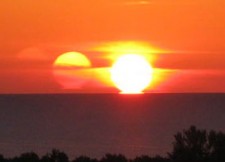Welcome to Tatooine
Just when I finally got away from Uncle Owen and Aunt Beru’s moisture farm, to join Biggs at the Academy, I find Tatooine’s twin suns have followed me all the way to Earth.
This picture, featured as the Astronomy Picture of the Day on the NASA web site (click the image to see the full-size original), has some people who think they know a thing or two about mirages and refraction in a bit of a fit.
Unfortunately, that includes me, since I’ve been so bold as to talk about superior and inferior mirages on the Skeptoid podcast, responsible for such oddities as the Min Min Light in Australia and the Marfa Lights in Texas. Those were easy, because they were vertically aligned, perpendicular to the inversion layers that bend the light and create them. If you note the tiny portion of inverted disk visible at the bottom of the sun in this picture, you can see an example of such a mirage.
But the obvious feature of this particular shot is that the second and third images are above and to the left of the actual sun. How’s that for a head scratcher?
Posters on the forum have, I think, identified what’s happening here. See if you can figure it out. It does help to have some knowledge of refraction. I’ll give you a hint: the photo has not been manipulated, and the solution has nothing to do with any in-camera effects like lens flare.
When you’re satisfied that you’ve warped your brain as far as it will warp, take a look at the forum. A few folks have even managed to replicate the effect seen in the photo.


It’s perfectly simple. There’s a layer of clouds BEHIND the Sun, and the second image is its reflection!
Does refraction from an optical filter count as an in-camera effect?
For this to be a mirage, I guess there’d have to be some vertical atmospheric layers, which isn’t likely.
I’ve got an example of this in my own photo album. The picture was taken through a window.
That’s roughly 0.7 degrees separation between the images so the window is certainly plausible if it is double-glazed with a fairly wide space between the two sheets. Has anyone checked the brightness of the images (well, ratio of image to immediate background) to see if we get the ~4% brightness for each duplicate? That’s 4% of the real sun, then 4% of 4% … of course the real sun may be saturated but a comparison of image #2 with image #3 should suffice.
Now here’s one that has me stumped and which I haven’t been able to find in books: back in 2000 I saw a partial rainbow over the sea and multiple images of the rainbow below the first bow. The images had the same color arrangement, were successively dimmer, and there was no gap between bows. I’d like to know if anyone’s seen a similar thing or has any idea how it can form.
How long until this image is used as proof of Planet X?
I didn’t think I had that picture online, but I checked this morning, and here it is:
http://www.flickr.com/photos/gr8wight/2928646966/in/set-72157609378822634/
The rainbow phenomenon is something I’ve seen only once in my life. They are called supernumerary rainbows and here is a reference http://www.jal.cc.il.us/~mikolajsawicki/rainbows.htm
As I read in the forum Brian recommended the general idea is that it was caused by the double window glass. As far as I know there is no information from the person who had made the picture about the circumstances (i.e. it was made from behind a window or not). Paul’s picture was again made from behind the CN Tower Restaurant window.
Would it also be possible to see something like this if the sun was setting as the moon was rising, or vice-versa? Or is it not possible for them to be that close (looking) at the same time? (And it probably wouldn’t look exactly like this, either, as the moon would likely be dark due to the side facing us not having a sun to reflect.)
Solar eclipse?
A UFO!